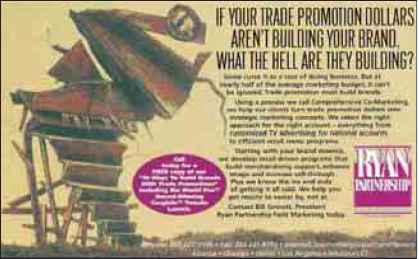Consumer Franchise Building versus Nonfranchise Building Promotions
Sales promotion activities that communicate distinctive brand attributes and contribute to the development and reinforcement of brand identity are consumer franchise building (CFB) promotions. Consumer sales promotion efforts cannot make consumers loyal to a brand that is of little value or does not provide them with a specific benefit. But they can make consumers aware of a brand and, by communicating its specific features and benefits, contribute to the development of a favorable brand image. Consumer franchise-building promotions are designed to build long-term brand prefer ence and help the company achieve the ultimate goal of full-price purchases that do not depend on a promotional offer.
This promotion agency ad stresses the importance of using trade promotions to build brand equity

For years, franchise or image building was viewed as the exclusive realm of advertising, and sales promotion was used only to generate short-term sales increases. But now marketers are recognizing the image-building potential of sales promotion and paying attention to its CFB value. Surveys have found that nearly 90 percent of senior marketing executives believe consumer promotions can help build brand equity while nearly 60 percent think trade promotions can contribute. Marketers recognize that the value of sales promotion extends well beyond quick-fix tactics such as price-off deals. Most sales promotion agencies recognize the importance of developing consumer and trade promotions that can help build brand equity. For example, the ad for Ryan Partnership that stresses how the agency develops trade promotions that help build brand equity.
Companies can use sales promotion techniques in a number of ways to contribute to franchise building. Rather than using a one-time offer, many companies are developing frequency programs that encourage repeat purchases and long-term patronage. Many credit cards have loyalty programs where consumers earn bonus points every time they use their card to charge a purchase. These points can then be redeemed for various items. Most airlines and many hotel chains offer frequent-flyer or guest programs to encourage repeat patronage. Many retail stores have also begun using frequency programs to build loyalty and encourage repeat purchases.
Companies can also use sales promotion to contribute to franchise building by developing an offer consistent with the image of the brand. An example of a successful consumer brand-building promotion is the Search for 2000 Uses Sweepstakes promotion for WD-40, shown in Exhibit 16-8. The WD-40 Company positions its brand as the leading multipurpose problem solver that cleans, protects, penetrates, lubricates, and displaces moisture like no other product on earth. The marketing strategy for WD-40 is to continually promote the myriad of uses for the product. The Search for 2000 Uses Sweepstakes, which was launched to coincide with the new millennium, asked consumers to suggest their use for WD-40 in order to be entered for a chance to win various prizes such as WD-40 can radios, T-shirts, and baseball caps and a grand prize of $10,000 in company stock. The sweepstakes reinforced WD-40's image as a multipurpose problem solver and also encouraged consumers to visit the company's website to enter their uses.
Search for 2000 Uses Sweepstakes is an excellent example of a consumer brand-building promotion

Nonfranchise-building (non-FB) promotions are designed to accelerate the purchase decision process and generate an immediate increase in sales. These activities do not communicate information about a brand's unique features or the benefits of using it, so they do not contribute to the building of brand identity and image. Price-off deals, bonus packs, and rebates or refunds are examples of non-FB sales promotion techniques. Trade promotions receive the most criticism for being nonfranchise building— for good reason. First, many of the promotional discounts and allowances given to the trade are never passed on to consumers. Most trade promotions that are forwarded through the channels reach consumers in the form of lower prices or special deals and lead them to buy on the basis of price rather than brand equity.
Many specialists in the promotional area stress the need for marketers to use sales promotion tools to build a franchise and create long-term continuity in their promotional programs. Whereas non-FB promotions merely borrow customers from other brands, well-planned CFB activities can convert consumers to loyal customers. Short-term non-FB promotions have their place in a firm's promotional mix, particularly when competitive developments call for them. But their limitations must be recognized when a long-term marketing strategy for a brand is developed.
Consumer-Oriented Sales Promotion
We study the consumer-oriented promotions and discuss their advantages and limitations. First, we consider some objectives marketers have for sales promotion programs targeted to the consumer market.
Continue reading here: Objectives of Consumer Oriented Sales Promotion
Was this article helpful?
Readers' Questions
-
diana2 months ago
- Reply
-
mewael fikru2 months ago
- Reply
-
Edmund10 months ago
- Reply
-
Veikko Mett1 year ago
- Reply
-
Isaac1 year ago
- Reply
-
armida1 year ago
- Reply
-
lee1 year ago
- Reply
-
Chica1 year ago
- Reply
-
virgilia1 year ago
- Reply
-
Susanne1 year ago
- Reply
-
lucas1 year ago
- Reply